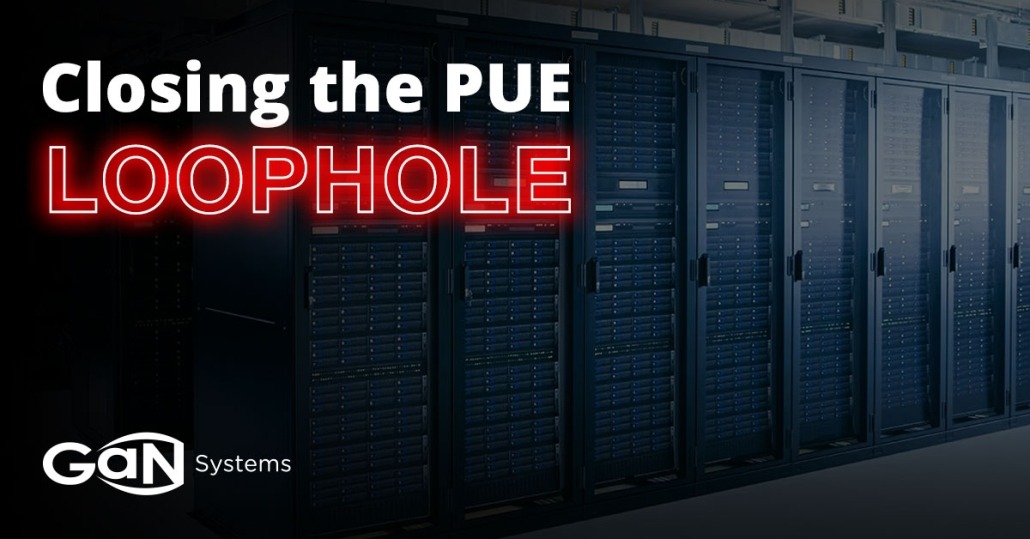GaN: Closing the data center “PUE Loophole”

How replacing silicon power semiconductors with Gallium Nitride (GaN) can help energy efficiency
Data centers today are running more compute-intensive workloads than ever, requiring rapidly increasing power consumption. In fact, data centers now account for roughly one to two percent of annual global power consumption—and a hyperscale data center can use as much power as 80,000 households. With the massive proliferation of data due to technologies like IoT and generative AI, pressures on data center operators will only increase.
I recently discussed this topic at Data Center World—focusing on how data center operators can reap massive gains in cost, efficiency, and sustainability by replacing silicon power semiconductors – the industry standard for more than 30 years – with Gallium Nitride (GaN) technology. GaN, now mainstream in several power applications, is a vital technology that can help data center operators dramatically increase profits, reduce operating expenses, and achieve sustainability goals.
So why aren’t all data operators flocking to GaN?
The PUE Loophole: A Data Center Blind Spot
Part of the reason why operators are not more rapidly moving to GaN is a lack of awareness of the “PUE loophole” – a shortcoming of the widely used power usage effectiveness (PUE) metric. GaN can plug this loophole.
The data center industry uses the PUE metric to measure the energy efficiency of a data center facility. Originally developed by a consortium called The Green Grid, the PUE is determined by dividing the total amount of power entering a data center by the power used to run the IT equipment within it.
Monitoring and improving PUE is a crucial aspect of data center operations. For instance, lowering the PUE is an indicator of reducing energy consumption and associated costs, and contributing to environmental sustainability by minimizing carbon emissions. Data center operators continuously strive to optimize their infrastructure and employ energy-efficient practices to achieve lower PUE values while maintaining optimal performance and reliability.
However, the PUE, like all metrics, is not perfect. It attempts to measure how efficiently the data center delivers power to servers, but it omits one crucial element – power conversion in the server itself. Therefore, the PUE calculation does not provide a comprehensive view of the energy efficiency within a data center—marking a significant “blind spot” for operators.
To understand the loophole, it’s important to recognize that power arrives at the server as AC, usually at a voltage of around 240V. However, the semiconductors in the server use low-voltage DC power. So, as a first step, the server must convert AC power to DC power, which typically takes place within a unit called a CRPS or simply an AC/DC converter. This conversion process wastes significant energy. Yet, the PUE metric ignores AC/DC conversion – and this is what we call the PUE Loophole.
The implications of the loophole are significant.
Because the PUE doesn’t consider AC/DC conversion efficiency in the server, there is no incentive to make AC/DC converters more efficient.
Many servers still use AC/DC converters that are 90 percent efficient or less. While this may sound impressive, consider that 10 percent or more of all energy in a data center is lost. Not only does this significantly increase costs and CO2 emissions, but it also creates extra waste heat, putting additional demands on cooling systems.
GaN can drive end-to-end reductions in power loss
This is where GaN comes in. The latest generation of GaN-based server AC/DC converters are 96 percent efficient or better – which means that more than 50 percent of the wasted energy can instead be used effectively.
Across the entire industry, this could translate into more than 37 billion kilowatt-hours saved every year—enough to run 40 hyperscale data centers!
GaN can provide an immediately cost-effective way to close the PUE loophole and save high amounts of energy. But the benefits of GaN in the data center don’t stop there.
For instance, there are further power conversion stages inside the server that can be improved by GaN. GaN can bring a 4x reduction in power loss and a 2x increase in power density for DC/DC conversion. These improvements lead to reduced energy wastage but also allow a single server board to carry increased processing power.
GaN also provides key advantages when it comes to the Uninterruptible Power Supply (UPS), a key component in data centers that provides backup power during outages. GaN can substantially improve the efficiency of UPS systems, reducing power losses by 56 percent and delivering 2.3x more power in the same space compared to traditional silicon-based components. This improved efficiency translates to lower energy consumption during normal operations and also allows for more compact and cost-effective UPS systems.
Only GaN can simultaneously boost efficiency and density to the levels demanded by the next generation of IT.
The Way Forward
While results driven by GaN in the data center are undeniable, greater awareness is essential regarding the current limitations of the PUE metric.
To be clear, despite the imperfect nature of the metric, PUE adds significant value, and it is clear that improving a data center’s efficiency can make a dramatic difference in the amount of power used overall.
By factoring in additional criteria that fall outside of the current PUE metric, such as efficiency within the rack itself, data center operators will be well-positioned for the future.
This article was originally published on DataCenterDynamics.com


